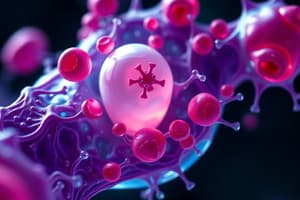Podcast
Questions and Answers
What is the main function of the mitochondria in a cell?
What is the main function of the mitochondria in a cell?
- Synthesis of lipids
- Creates ATP through oxidative phosphorylation (correct)
- Regulation of cell shape
- Translation of mRNA into proteins
Which organelle is responsible for the degradation of intracellular proteins?
Which organelle is responsible for the degradation of intracellular proteins?
- Lysosome
- Proteosome (correct)
- Golgi apparatus
- Peroxisome
What is the main function of the smooth ER?
What is the main function of the smooth ER?
- Synthesis of lipids (correct)
- Synthesis of proteins
- Intracellular degradation
- Cellular uptake of cholesterol
What is the function of the cytoskeleton in a cell?
What is the function of the cytoskeleton in a cell?
What is the composition of the cell membrane?
What is the composition of the cell membrane?
What is the function of the Golgi apparatus in a cell?
What is the function of the Golgi apparatus in a cell?
What is the role of cholesterol in the cell membrane?
What is the role of cholesterol in the cell membrane?
What is the function of the endosome in a cell?
What is the function of the endosome in a cell?
What percentage of the membrane is composed of membrane proteins?
What percentage of the membrane is composed of membrane proteins?
What type of protein becomes the receptors inside the cell?
What type of protein becomes the receptors inside the cell?
What is the purpose of the hemoglobin A1C test?
What is the purpose of the hemoglobin A1C test?
In which type of protein is a carbohydrate attached?
In which type of protein is a carbohydrate attached?
What is the direction of movement in diffusion?
What is the direction of movement in diffusion?
What is the primary difference between osmosis and diffusion?
What is the primary difference between osmosis and diffusion?
What is the characteristic of transport that differentiates it from diffusion and osmosis?
What is the characteristic of transport that differentiates it from diffusion and osmosis?
What is the purpose of the sodium/potassium pump?
What is the purpose of the sodium/potassium pump?
Flashcards are hidden until you start studying
Study Notes
Cellular Organelles and Their Functions
- Cytosol: involved in metabolism, protein synthesis, and cell signaling
- Cytoskeleton: maintains cell shape, enables cell movement, and facilitates transport
- Nucleus: holds genome, synthesizes DNA and RNA
- Mitochondria: generates ATP through oxidative phosphorylation, stores calcium
- Smooth ER: synthesizes lipids, stores calcium
- Ribosomes: translates mRNA into proteins
- Rough ER: translates mRNA into membrane proteins for secretion
- Lysosome: facilitates intracellular degradation
- Endosome: mediates cellular uptake of cholesterol, removal of receptors from the plasma membrane, uptake of small molecules and water into the cell
- Golgi Apparatus: modifies, sorts, and packages proteins and lipids for delivery within the cell or secretion
- Proteosome: degrades intracellular proteins
- Peroxisome: detoxifies substances
Cell Membrane Composition
- 5 nm-thick lipid bilayer composed of lipids, cholesterol, proteins, and carbohydrates
- Lipids include phospholipids and phosphoglycerides
- Polar ends form the surface (hydrophilic) and non-polar ends face inward (hydrophobic)
- Composition varies according to cell type
- Lipid bilayer helps with cell signaling
- Cholesterol stabilizes the membrane at normal body temperature, involved in cell building and repair
Membrane Proteins
- 50% of the membrane is composed of membrane proteins (integral, lipid-anchored, or peripheral)
- Integral proteins: embedded in the lipid bilayer, span the bilayer (transmembrane proteins), act as receptors inside the cell
- Lipid-anchored proteins: covalently bonded to lipid molecules
- Peripheral proteins: associated with the lipid bilayer, often bound to integral or lipid-anchored proteins
- Outer membrane proteins undergo glycosylation (attachment of a carbohydrate to a protein)
Cellular Processes
- Diffusion: particles move from high to low concentration areas
- Osmosis: water moves from high to low concentration areas
- Transport: movement of molecules or substances, can go against the concentration gradient (requires energy)
- Active transport: uses ATP, example: Sodium/ Potassium pump
Studying That Suits You
Use AI to generate personalized quizzes and flashcards to suit your learning preferences.




